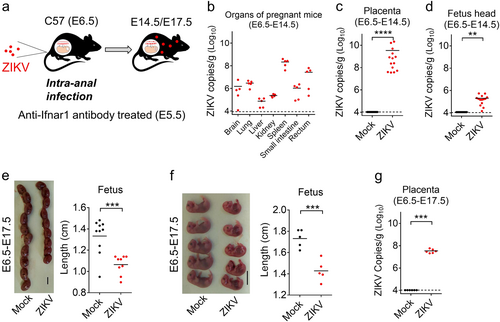Figures & data
a Experimental outline for ZIKV infection. Mice were infected with 105 PFU of either ZIKV (GZ01 strain) or DENV-2 (43 strain) by the i.p. route. b–d RNA in the sera (b), anal lavage fluid (c), and feces (d) from ZIKV- or DENV-infected Ifnar1−/− mice was analyzed at the indicated time points by qRT-PCR using primers specific for each virus. (n ≥ 5 per group)
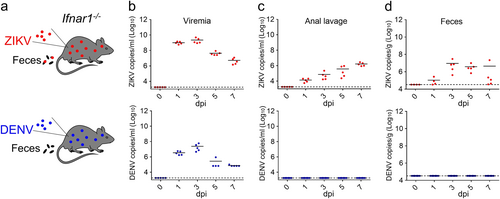
a–b 3–4-week-old C57 mice were pretreated with anti-Ifnar1 antibody (a) or mock-treated (b) for 12 h and then infected with ZIKV (GZ01 strain, 106 PFU/mouse) by the i.p. route. ZIKV RNA copies in the blood, anal lavage and feces at the indicated times were quantified by qRT-PCR (n = 4 per group)
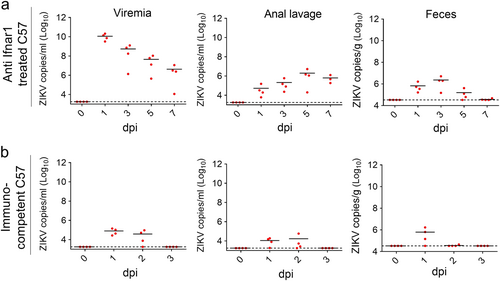
a Illustration of the experiment. 3–4-week-old male Ifnar1−/− mice were infected with ZIKV (106 PFU/mouse) by the i.a. route (a–f). b The survival rate of the infected Ifnar1−/− mice (n = 6 per group). **p < 0.01, log-rank (Mantel–Cox) test. c Viral RNA copies in sera were measured at the indicated time points by qRT-PCR assay (n = 5 per time point). d ZIKV RNA recovered from the brain, lung, liver, kidney, spleen, testes, small intestine, and rectum were quantified by qRT-PCR (n = 4 per group). e The size and weight of the testes from uninfected or ZIKV anally-infected Ifnar1−/− mice were measured at 15 dpi (n = 6, mock; n = 8, ZIKV). Scale bar = 0.5 cm. ****p < 0.0001, unpaired Student’s t-test. f RNA in situ hybridization of organ tissues from mock-infected or ZIKV anally-infected Ifnar1−/− mice with a ZIKV-specific probe at 5 dpi. Scale bar represents 100 μm. The data in (f) are representative of two independent experiments with at least two animals per group
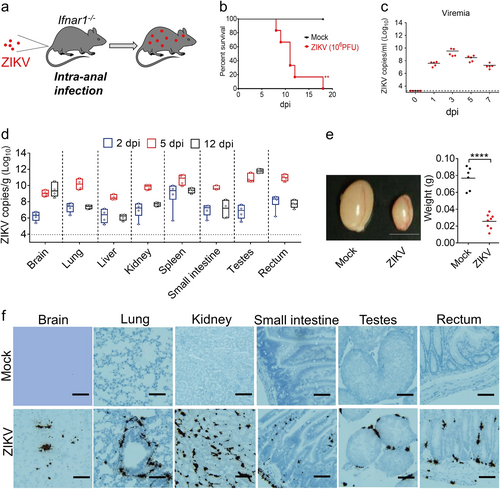
a Expression levels of cytokines and chemokines in sera from ZIKV anally-infected Ifnar1−/− mice (106 PFU/mouse), analyzed by Luminex assay at 7 dpi. The average expression levels of cytokines from 3 mice are shown. b Relative expression levels of the 30 innate immune response genes in human colon cells (HT-29) most upregulated by ZIKV infection. The cells were infected with ZIKV (GZ01 strain, MOI 0.5) for 24 h, and total RNA was extracted and analyzed by RNA-seq. c, d Pathways for the up- (c) or down- (d) regulated genes enriched by gene ontology pathway analysis. "-" means "negative". e The mRNA expression levels of IFNB, MX1, and IP-10 in ZIKV-infected (GZ01 strain, MOI 1) HT-29 cells were measured by qRT-PCR at the indicated time points. All data are shown as the mean ± SEM. *p < 0.05, **p < 0.01, unpaired Student’s t-test
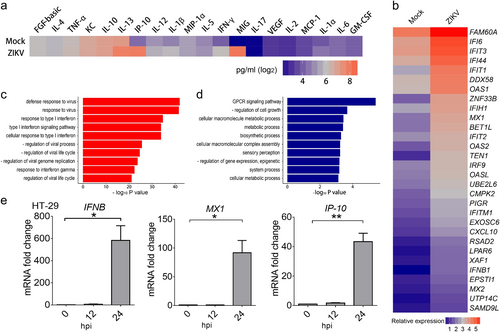
a Illustration of the experiment. 7–8-week-old C57 mice were mated, and pregnant mice were infected i.a. by ZIKV (106 PFU/mouse) at E6.5 after treatment with anti-Ifnar1 antibody at E5.5. Mice were euthanized at E14.5 (E6.5-E14.5) or E17.5 (E6.5-E17.5). b–d ZIKV RNA copies recovered at E14.5 (8 dpi) from tissues of pregnant mice, including the brain, lung, liver, kidney, spleen, small intestine, and rectum (n = 5 per group) (b), or the offspring of 2 representative pregnant mice including the placenta (c) or the fetal head (d) were quantified by qRT-PCR (n = 9, Mock; n = 14). e, f Condition and length of individual fetuses at E17.5 (en = 10 Mock; n = 9 ZIKV; fn = 5 per group). The size of each fetus within the amniotic sac is shown in (e), while (f) shows the length measured when the placenta and amniotic tissues are removed. Scale bar = 1 cm. g Viral load in the placenta at E17.5 (n = 6 per group). Offspring in (e–g) were from one representative pregnant mouse. **p < 0.01, ***p < 0.001, ****p < 0.0001, unpaired Student’s t-test
